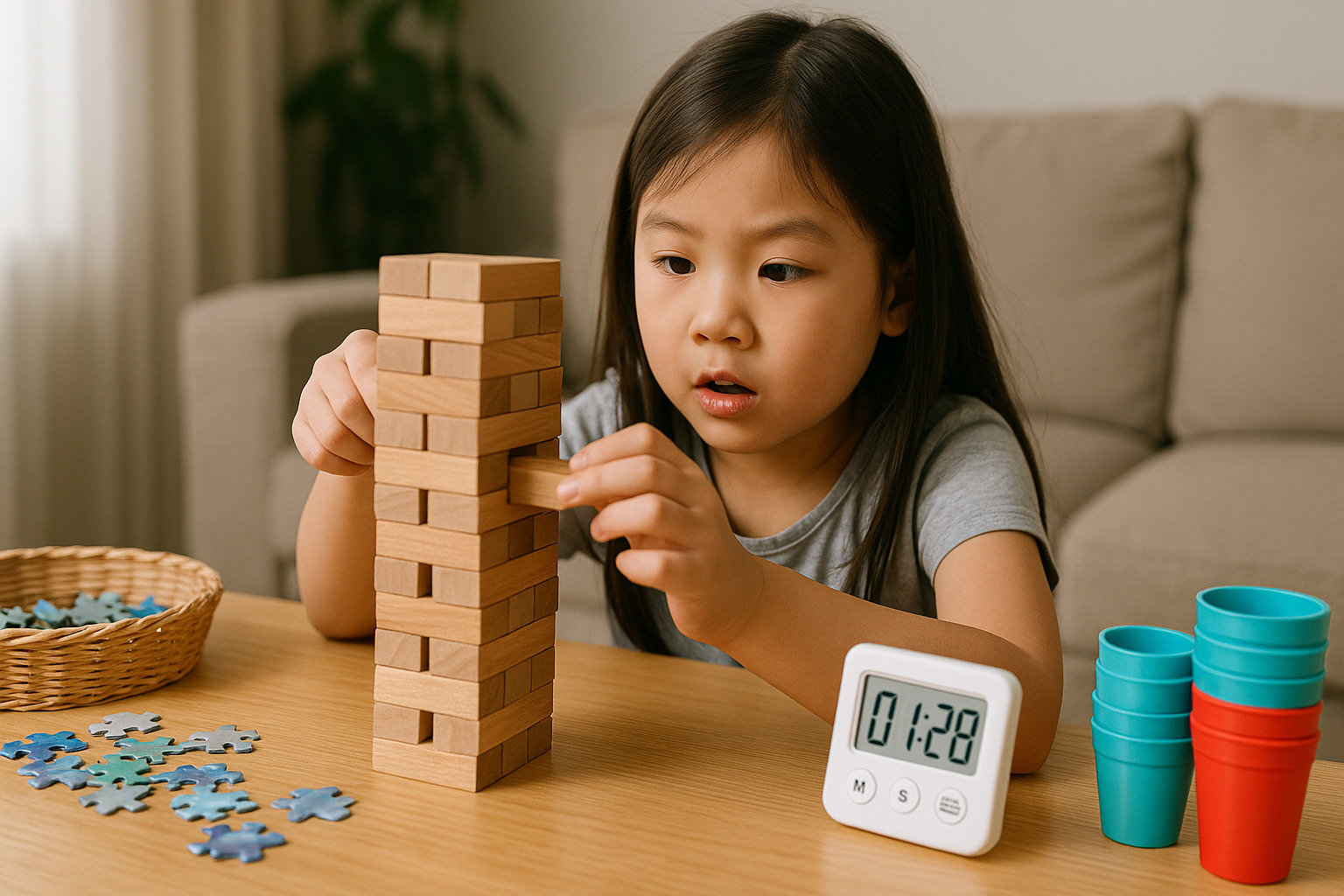Can games really help children build focus and patience? Yes—when chosen with purpose and played with structure, certain indoor games can sharpen attention spans and stretch patience in playful, rewarding ways. These activities require minimal setup, can be adapted for different age groups, and offer a break from overstimulation.
Here are fun indoor games that do more than entertain. They train the mind, encourage impulse control, and teach kids how to persist without melting down. Each one includes a simple mechanic, rules to stick with, and clear start-to-finish flow—ideal for building habits that last beyond the playroom.
1. Beat the Clock
How it works: Set a task and give a countdown—stacking blocks, sorting objects by color, folding laundry, or matching socks. The goal is to finish before time runs out.
Why it works: The clock creates urgency while teaching time awareness. Kids learn how to pace themselves, resist distractions, and handle the pressure of a ticking deadline. An online timer works well for this, especially when displayed on a screen for everyone to see.
What you’ll need: Household objects, timer, space to move.
2. Freeze Dance with a Twist
How it works: Play music and have children dance freely. Stop the music at random moments. When it stops, everyone must freeze in place—no blinking, no giggling, no wobbling.
Add a challenge: Assign each freeze a position: “Freeze like a statue,” “Freeze like a frog,” or “Freeze like you’re in outer space.” Add a point system for holding the freeze without moving.
Why it works: It trains children to listen carefully and respond quickly. Holding still improves body control and lengthens focus. The game mixes fun with behavioral restraint.
What you’ll need: Music player, playlist, open space.
3. Puzzle Races
How it works: Set a timer and challenge kids to complete puzzles within a set timeframe. Use age-appropriate puzzles and increase difficulty gradually.
Why it works: Puzzles require visual concentration, memory, and persistence. The time pressure adds intensity while forcing players to stay calm and solve logically. A fun option is trying a free online nonogram—a logic puzzle that reveals a hidden picture as kids fill in the correct squares.
What you’ll need: Puzzles of varying sizes, flat surface, optional timer.
4. Sock Sorting Challenge
How it works: Empty a laundry basket filled with mismatched socks. Ask kids to find and match pairs as quickly as they can. To increase difficulty, mix in gloves or similar items as decoys.
Why it works: Matching requires observation, comparison, and fast decision-making. Speed forces kids to stick with the task while resisting the urge to give up when it’s not easy.
What you’ll need: Pile of socks, stopwatch or clock.
5. Cup Stacking Towers
How it works: Give each child a set of plastic cups and challenge them to build the tallest free-standing tower. For older kids, set design restrictions like “only 10 cups allowed” or “you must build a pyramid shape.”
Why it works: The task encourages spatial reasoning, trial and error, and patience. Towers fall. Kids start again. And through that process, they build mental stamina.
What you’ll need: Plastic cups, flat surface, measuring tape (optional).
6. Memory Tray Game
How it works: Place 10–15 small items on a tray. Give players 30 seconds to memorize them. Cover the tray. Ask them to list or write down everything they remember. Add or remove items between rounds to keep it fresh.
Why it works: This classic sharpens attention to detail, short-term memory, and focus under a time constraint. It also builds calm under pressure—a must-have for test-taking and real-life recall tasks.
What you’ll need: Tray, assorted household items, towel or cloth to cover, paper and pencils.
7. Thread the Needle
How it works: Provide a needle with a large eye (or use a child-safe plastic version) and thread. The challenge: thread the needle in under one minute. For younger children, use pipe cleaners and beads.
Why it works: Fine motor control, hand-eye coordination, and steady focus are all required. It’s quiet, slow, and demands patience—ideal for kids who need help slowing down.
What you’ll need: Needle and thread, beads and string, pipe cleaners, stopwatch.
8. Shadow Copy Game
How it works: One player acts as the leader and moves slowly—raising arms, squatting, spinning. The others must copy the movements exactly, like a shadow. The leader tries to throw off the followers with surprise pauses or slow-motion tricks.
Why it works: It requires total attention and physical control. Kids must stay focused on subtle movement changes and react without lag.
What you’ll need: Open space, creativity.
9. Jenga with Challenges
How it works: Use a Jenga set and write short challenges on each block—“Count to 10 backwards,” “Touch your toes and stand still,” “Name 3 animals that can fly.” When a player pulls a block, they must complete the challenge before the next turn.
Why it works: Kids pause between moves to complete a mini-task. The shift in focus, plus the balance needed to keep the tower standing, helps train self-regulation and mental flexibility.
What you’ll need: Jenga blocks, marker for writing challenges.
10. The Listening Game
How it works: Read a short story or play an audio clip. Then ask questions about what was just heard—details, names, sequence of events. Gradually raise the difficulty.
Why it works: Active listening is foundational to learning and following instructions. This game rewards those who pay attention and stay mentally present.
What you’ll need: Short stories, audio clips, set of prepared questions.
These games aren’t just for rainy days or school holidays. They can be part of daily routines, birthday parties, or weekend family time. They give children tools they’ll need in school, at home, and with peers—tools to pause, listen, think, and act with care. No screens required. Just play, purpose, and presence.



